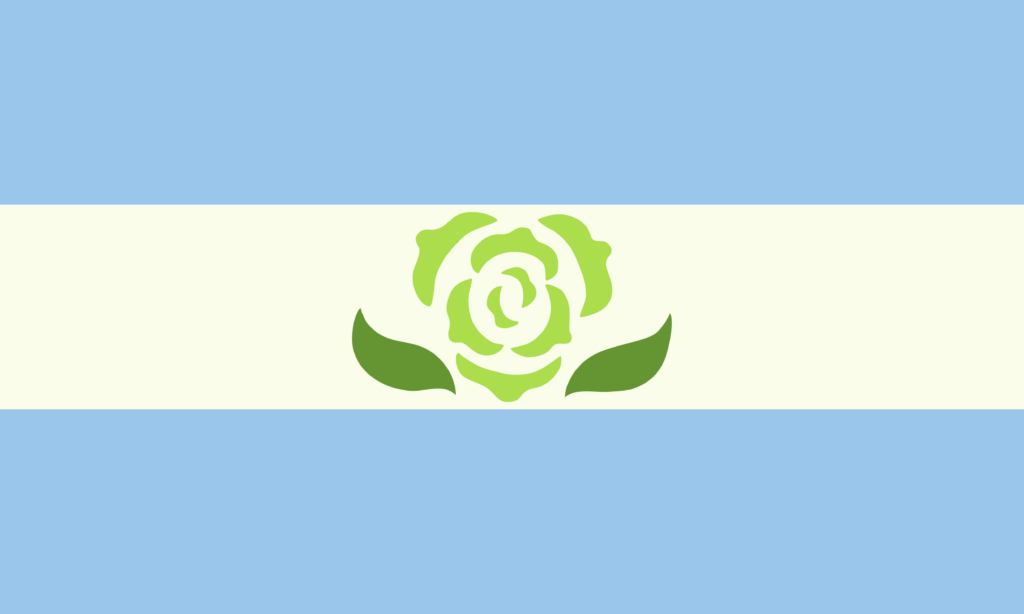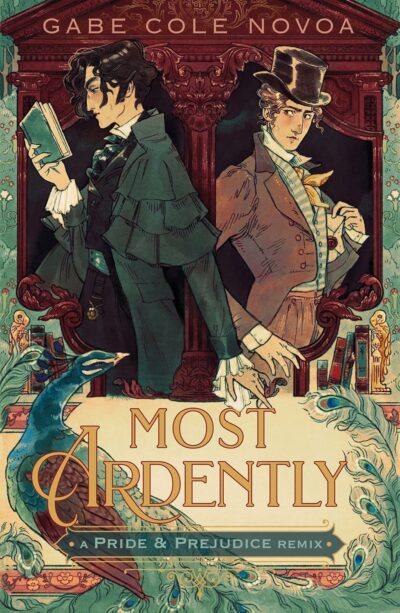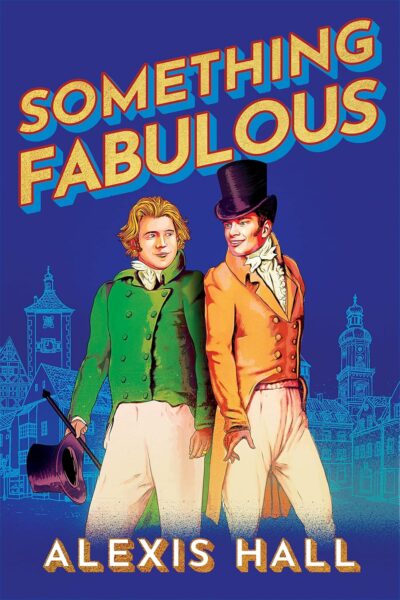Last month I sought to honor the shared history of the blue violet and the white lily as symbols of Sapphic love. Today we’re doing the same for their Achillean cousins: the green carnation and the red rose. And at the end, we’ll have some graphic novel and chapter book recommendations!
A Queer History of Green Carnations
Unlike the blue violet, which became a queer symbol as a result of broad cultural trends observed in the 19th and 20th centuries, the green carnation comes from a highly specific origin: Oscar Wilde wore one.

Oscar Wilde Tours, which provides gay history tours in cities across the globe, goes into further detail about the history of Wilde’s green carnation and the deliberate ambiguity of its meaning. While we don’t know whether or not Wilde intended to hint at his love for men, the green carnation has nevertheless been adopted by the queer community and emblazoned upon the Achillean flag. Said flag was crafted to be an inclusive symbol of love between queer men regardless of their preferred label. I’ve tried to honor that inclusivity and diversity in my recommendations.
A Queer History of Red Roses
In last year’s blog post for Pride, I couldn’t really get into the history of the lily as a Japanese symbol of Sapphic love due to said history being rather unclear and a bit contentious. There are too many possibilities to discuss, and I do try to keep these posts a reasonable length.
Really, I do.
Don’t look at me like that.
Thankfully the queer history of bara, the Japanese word for roses, is comparatively well-documented and straightforward. Bara was once a pejorative for gay men in Japan in the mid-20th century but was famously reclaimed in the 1961 photobook Barakei: Killed by Roses by Eikoh Hosoe, followed ten years later by Barazoku, the first commercially available gay magazine in Japan.
While Sapphic romance fiction from Japan is referred to as Yuri—the Japanese word for lilies—gay romance comes in two genres: BL and gei komi. BL, which stands for “Boy’s Love,” tends to favor pretty, slender and clean-shaven men for its romantic leads. Gei komi, which is a transliteration of “gay comics,” tends to feature big, muscle-gutted men with chests and facial hair. In North America, many anime and manga fans refer to the latter genre and its associated character archetype as bara.
Both of my manga recommendations on this list fall under the BL category. As such, I would like to give an additional recommendation to the works of Gengoroh Tagame, the premier gei komi mangaka in all of Japan. Tagame-sensei has received critical acclaim in the United States for his dramatic works, but he’s equally skilled in creating art that’s fun and tantalizing.
What is White Day?
One more history lesson before the recommendations!
So why are we looking at gay fiction in the middle of March? Well, we’re celebrating White Day on March 14, a holiday that spawned from Japan’s unique Valentine’s traditions.
Valentine’s Day was adopted by Japan early on in the 20th century, but it didn’t really catch on with the public until the 70s. At that time, Valentine’s Day became an opportunity for women to celebrate the men in their lives with gifts of chocolate. Friends, family and coworkers receive giri-choco (roughly “obligation/courtesy chocolate”), while honmei-choco (“true feelings chocolate”) is given to partners and desired partners. On White Day, the men reciprocate by giving gifts to whoever gave them chocolate. In keeping with the theme of the day, return gifts are often white items such as white chocolate, marshmallows or lotions.
Those are the broad strokes of White Day in Japan. But keep in mind that trends and traditions are everchanging. That’s especially true of traditions that are heavily reliant on gender roles and heteronormativity. As gender roles change and queer relationships become more accepted, traditions either adapt or fall out of fashion.
Still, as the real world marches forward, traditions like these continue to be recognized in fiction. Valentine’s and White Day feature prominently in anime and manga, and rightfully so. They provide an excellent source of drama, romance or comedy as well as an opportunity to play with these assumed gender roles. A frequent gag in anime nowadays is for the coolest girl in school to receive way more chocolates than any of the boys.
So, since last month we celebrated the day women confess their love by looking at a mix of Yuri manga and Sapphic novels, let’s look at their BL and Achillean brothers to honor the day men express their love and gratitude.
BL Manga and Achillean Novel Recommendations
Most Ardently: A Pride and Prejudice Remix by Gabe Cole Novoa
 As it says on the tin, this YA novel is a retelling of Jane Austen’s classic Pride and Prejudice with an emphasis on Pride. Lizzy Bennett is reimagined as Oliver Bennett, a young trans man struggling against the rigid gender roles of Regency society. The story is largely the same but told more closely from Oliver’s perspective.
As it says on the tin, this YA novel is a retelling of Jane Austen’s classic Pride and Prejudice with an emphasis on Pride. Lizzy Bennett is reimagined as Oliver Bennett, a young trans man struggling against the rigid gender roles of Regency society. The story is largely the same but told more closely from Oliver’s perspective.
The original Pride and Prejudice is told quite differently than how we think of prose novels today. The narration has an almost voyeuristic eye, relaying the story as if the narrator is dishing out the latest gossip on the Bennett family. Most Ardently opts for a closed third-person point of view, granting the story a deeper intimacy while also fitting more contemporary trends. It’s a good choice for the story Novoa is telling, in which Oliver’s struggles with gender dysphoria and attainment of gender euphoria are center stage.
It’s best not to approach this book as something trying to emulate Jane Austen’s style of storytelling, but as something using a classic piece of literature as a jumping-off point to tell a new story informed by the author’s personal experiences. Think along the lines of Wide Sargasso Sea in relation to Jane Eyre.
If you go into this story with the right mindset, Most Ardently is a moving and deeply personal story built on top of the framework of one of the greatest British classics. It’s the sort of historical fiction that aims to bring the past to you, rather than pull you into the past. I know some prefer the latter, but if you can open your mind to the former, then Most Ardently is just one of the many emotionally compelling stories you’ll be able to enjoy.
Given by Natsuki Kizu
Given is the story of bandmates falling in love. Hot-headed guitarist Ritsuka falls for meek vocalist Mafuyu, who has a mysterious but doubtlessly tragic backstory. Meanwhile, mature bassist Haruki harbors a crush on playboy drummer Akihiko, who has an on-and-off relationship with his roommate. Relationships fall apart and are born anew in this intense drama. And with Ritsuka and Mafuyu being in high school while Haruki and Akihiko are college-aged men, this title has a broad appeal for both teens and adults.
Part of what grabbed me was how grounded the story and characters are. Many anime and manga have over-the-top characters and scenarios, and indeed that’s a significant part of their appeal. So when a manga is as raw and real as Given, that context gives it additional weight. Given is far from the only manga like this, but it’s a great example of the breadth and depth of stories manga can offer.
I also think this is a good introduction for people who don’t normally read gay romance. Ritsuka reminds me of a lot of boys I knew in high school and junior college, so I think a lot of male readers will find him relatable regardless of sexual orientation. And while Akihiko is rough around the edges, he’s a compelling character who just happens to be a bisexual man, and that can be frustratingly hard to find in fiction.
With such a compelling cast of characters, I highly recommend giving this series a shot.
Something Fabulous by Alexis Hall
Last month we had The Parent Trap with Victorian lesbians, now get ready for Planes, Trains and Automobiles with Regency-era demisexuals and gay men.
Valentine Layton, Duke of Malvern, knows what his lot in life is. He’s to marry Arabella Tarleton at the wish of his father. Arabella is not so accepting. Wanting to marry for love, Arabella runs away and Valentine isn’t terribly heartbroken about it.
Unfortunately for Valentine, he has not one but two hopeless romantics to contend with. Bonny Tarleton is Arabella’s twin brother, and he’s every bit as impulsive as his sister. He fully expects Valentine to give chase and sweep Arabella off her feet, and the Duke just can’t say “no” to that face.
It’s not long before Bonny has Valentine at his wit’s end, and not just because the boy’s a bit overdramatic. As he draws closer to Bonny, Valentine can’t deny which of the two Tarletons he prefers. This adult novel will drag our two leads across Britain and into each other’s hearts.
I was first introduced to Alexis Hall’s work with the title A Lady for a Duke, which tells the story of a trans woman in Regency-era Britain falling in love with her childhood friend. Queer Regency romance is a well Alexis Hall comes back to every now and again with great success. Witty and soulful, Hall’s prose effortlessly bounces between humor and drama, keeping the tone of their work balanced on a knife’s edge.
An author repeatedly going back to the same well of ideas runs the risk of their books feeling samey, but Hall expertly dodges this pitfall by playing around with genre. While A Lady for a Duke features grounded leads navigating the difficulties of shellshock, addiction and hurt people hurting one another, Something Fabulous is an absurd romantic comedy about one man annoying another into loving him. A Lady tries to tell a queer story that could believably exist in its designated historical context, while Something Fabulous comes from the Bridgerton school of valuing the aesthetics of empire line dresses and frock coats over strict historical accuracy. While homosexuality has never been as rare as some people like to believe, the way Valentine and Bonny can hardly take three steps without bumping into another campy queer character might require just a tiny bit of suspension of disbelief.
With such a big supporting cast of queer characters and a delightfully odd couple as our leading pair, this silly romp is a wonderfully garish celebration of queerness; a veritable Pride parade in book form. If you love gay camp, then I can’t recommend this one enough.
Terano-kun & Kumazaki-kun by Yoriko
Just like last month, we’re ending with a heavy pinch of spice.
This one-volume adult manga tells the story of Terano, the student council president, and Kumazaki, a rebellious delinquent. Little does anyone know that big, scary Kumazaki is actually wrapped around Terano’s little finger.
The keyword to this book’s appeal is “balance.” Terano and Kumazi’s passion for one another is shared equally through sweet words and sweaty actions. Our leads are equal parts aggressive and caring toward one another. There’s some bodice-ripping (or, I suppose I should say, “jacket-ripping”) action, but never to the point that Kumazaki’s consent is questionable. This story hits the Goldilocks zone, providing the thrill of aggressive passion without feeling like an unhealthy relationship.
Terano could have simply been the aggressive, teasing romantic lead and that would have been enjoyable in its own way, but the ease with which his softer side comes out grabbed my attention and made the story far more compelling. Kumazaki, meanwhile, is a cute and bashful love interest despite his rugged looks but avoids being a total pushover when it comes to Terano. This sort of balancing act isn’t easy to pull off, yet Yoriko-sensei almost makes it look effortless.
The first chapter covers their hot and steamy first time together, while the second chapter flashes back to the achingly sweet story of how they fell in love in the first place. I was taken aback by just how beautiful their backstory was, and it made me wish this could have been a longer series.
There’s not a lot else to say about this one since this book is a single volume, and there isn’t much of a “plot” in the traditional sense. It’s a simple story about two young men intimately expressing their love for each other. The two leads are endearing, and their romance shows how love and lust are not necessarily at odds with one another but can instead enhance each other to create a more compelling story. If you appreciate a sexy story with a lot of heart, this one’s for you.



